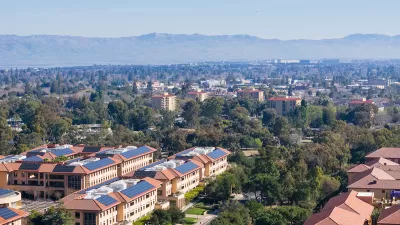More analysis and more equity will be required for Palo Alto to finally adopt a Housing Element that complies with state laws.

For a second time, the California Department of Housing and Community Development (HCD) has rejected a Housing Element from the city of Palo Alto in accordance with the Regional Housing Needs Assessment process. The city adopted the most recent Housing Element in May and had already begun the process of revamping its zoning code to meet its goals for 6,000 new housing units in the next eight years.
According to an article by Gennady Sheyner for the Palo Alto Weekly, the Housing Element rejected by the HCD calls for “raising the allowed density in multi-family zones and encouraging residential construction in historically commercial areas in the southeast portion for the city, around San Antonio Road and Fabian Way.” The Housing Element also expands the city’s new Housing Incentive Program (HIP), “which grants density and height bonuses, as well as other zoning breaks, to housing developers,” according to Sheyner.
“The letter from the HCD does not take issue with any of these proposed programs and concurs that the HIP is a great tool for housing developments,” report Sheyner. “The agency also found, however, that the city has not done enough to prove that the non-vacant sites on the city’s adopted housing inventory are actually suitable for housing.”
“The HCD also found that the city has not sufficiently analyzed some of the existing commercial zones for potential addition of residential use,” adds Sheyner.
The HCD first rejected Palo Alto’s Housing Element in March, before the city adopted its revised Housing Element in May. The city has until Jan. 31 to complete a compliant Housing Element. Until them, the city is subject to “Builder’s Remedy” proposals that are not subject to the boundaries set by local zoning laws. According to Sheyner, the city already has four such proposals in the pipeline.
FULL STORY: State again rejects Palo Alto's housing plan

Alabama: Trump Terminates Settlements for Black Communities Harmed By Raw Sewage
Trump deemed the landmark civil rights agreement “illegal DEI and environmental justice policy.”

Planetizen Federal Action Tracker
A weekly monitor of how Trump’s orders and actions are impacting planners and planning in America.

Why Should We Subsidize Public Transportation?
Many public transit agencies face financial stress due to rising costs, declining fare revenue, and declining subsidies. Transit advocates must provide a strong business case for increasing public transit funding.

Understanding Road Diets
An explainer from Momentum highlights the advantages of reducing vehicle lanes in favor of more bike, transit, and pedestrian infrastructure.

New California Law Regulates Warehouse Pollution
A new law tightens building and emissions regulations for large distribution warehouses to mitigate air pollution and traffic in surrounding communities.

Phoenix Announces Opening Date for Light Rail Extension
The South Central extension will connect South Phoenix to downtown and other major hubs starting on June 7.
Urban Design for Planners 1: Software Tools
This six-course series explores essential urban design concepts using open source software and equips planners with the tools they need to participate fully in the urban design process.
Planning for Universal Design
Learn the tools for implementing Universal Design in planning regulations.
Caltrans
Smith Gee Studio
Institute for Housing and Urban Development Studies (IHS)
City of Grandview
Harvard GSD Executive Education
Toledo-Lucas County Plan Commissions
Salt Lake City
NYU Wagner Graduate School of Public Service




























